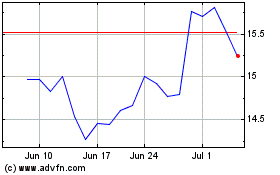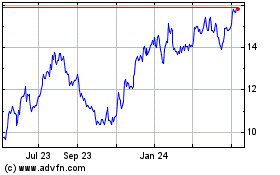Bank Of America Settlement Viewed As Blueprint For More Pacts
June 29 2011 - 2:39PM
Dow Jones News
The $8.5 billion pact that Bank of America Corp. (BAC) reached
with a group of institutional investors Wednesday could be a
blueprint for claims other banks face over soured mortgage-backed
securities.
Though analysts were split in their opinions as to whether such
a result would be good or bad for banks, investors expressed relief
that a major worry of the financial crisis could be put in the
rear-view mirror.
Bank of America, in its settlement, paid more than most analysts
expected but the pact was viewed in the market as removing a
significant question mark from the company's future. Shares rose
3.3% to $11.18.
Meanwhile, shares of other banks rose as investors hoped they
could now use the Bank of America settlement as a basis for their
own agreements. J.P. Morgan Chase & Co. (JPM) rose 2.4% to
$40.50, while Citigroup Inc. (C) advanced 2.9% to $41.33 and Wells
Fargo & Co. (WFC) added 1.3% to $27.86.
Still, the high cost paid by Bank of America was raising
expectations for what other banks might have to pay to investors
claiming the mortgages underlying the securities they purchased had
been improperly underwritten. And other analysts fretted that
investors, not just banks, could use the settlement for a
blueprint, leading to more demands for settlements.
"The good news is it implies the exposures are very manageable
relative to capital and tangible book values," Nomura analysts
said. "The bad news is now that BofA has settled, it would stand to
reason that investors will look for settlements from others as
well."
Bank of America, the nation's biggest bank by assets, certainly
had the biggest headache in mortgages. Between 2004 and 2008, the
bank sold some $963 billion in mortgage-backed securities to
private investors.
Bank of America said that, by paying $8.5 billion, it was taking
care of $424 billion in original principal, of which $221 billion
was unpaid. This means the bank was paying 2 cents on the dollar
for the initial principal and just under 4 cents on the dollar on
the unpaid principal.
In addition, Bank of America said it could face an additional $5
billion in private losses. That means it is estimating it would
have to pay less than 1 cent for every dollar in the remaining
outstanding initial principal.
Nomura said Bank of America, and Countrywide, likely has a
particularly severe loan book, so using the math from the
settlement at other banks is "far from perfect" but can at least
provide a benchmark.
Nomura, using the 4-cent rate Bank of America had on unpaid
principal and reducing it to account for differences at each bank,
estimated Wells Fargo could face $700 million in a potential
settlement.
The firm also estimated that Capital One Financial Corp. (COF)
could settle its unpaid balances for $600 million, while First
Horizon National Corp. (FHN) and SunTrust Banks Inc. (STI) could
settle for $200 million each.
Meanwhile, JMP analysts said costs are likely to be higher than
expected at J.P. Morgan and Citigroup, given Bank of America's
settlement.
J.P. Morgan said it had $180 billion in unpaid principal amounts
at the end of March, adding repurchase claims have been limited. It
had forecast $3.5 billion in liabilities for losses.
If the same math that Bank of America had were applied to J.P.
Morgan--to be sure, an estimate that can't necessarily be
assumed--J.P. Morgan could be facing $7.2 billion in potential
settlement costs.
At Citigroup, its unpaid principle balance was $36 billion at
the end of March. If Bank of America's payment was duplicated
there, again an assumption that potentially oversimplifies, Citi
could be facing about $1.44 billion in any settlement.
-By David Benoit, Dow Jones Newswires; 212-416-2458;
david.benoit@dowjones.com
First Horizon (NYSE:FHN)
Historical Stock Chart
From Mar 2024 to Apr 2024

First Horizon (NYSE:FHN)
Historical Stock Chart
From Apr 2023 to Apr 2024
